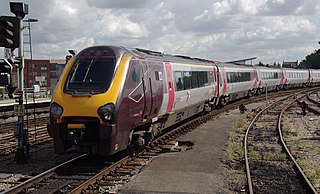Cross Country Route
| Cross Country Route | |
|---|---|

A class 221 Super Voyager leaving Bristol Temple Meads station
|
|
| Overview | |
| Type | Suburban rail, Heavy rail, Inter-city rail |
| System | National Rail |
| Status | Operational |
| Termini |
York Bristol Temple Meads |
| Stations | 48 |
| Operation | |
| Owner | Network Rail |
| Operator(s) |
CrossCountry (principal operator) Arriva Trains Wales East Midlands Trains Great Western Railway TransPennine Express Grand Central London Midland Northern Virgin Trains |
| Rolling stock |
Class 43 HST (main stock) Class 170 Turbostar (main stock) Class 220 Voyager (main stock) Class 221 Super Voyager (main stock) |
| Technical | |
| Track gauge | 1,435 mm (4 ft 8 1⁄2 in) standard gauge |
| Electrification | Partial 25 kV AC OHLE |
| Operating speed | Up to 125 mph (200 km/h) maximum, some sections limited to 100 mph (160 km/h) |
The Cross-Country Route is a long-distance UK rail route that has in its central part superseded the Midland Railway. It runs from Cornwall via Bristol, Birmingham, Sheffield and Leeds and the north east to Scotland. It facilitates some of the longest passenger journeys in the UK such as Penzance to Aberdeen. In the summer services are provided to additional coastal stations such as Newquay.
The line is classed as a high-speed line because the sections of the line from Birmingham to Wakefield and from Leeds to York have a speed limit of 125 mph (200 km/h), though the section from Birmingham to Bristol is limited to 100 mph (160 km/h) due to there being numerous level crossings, especially half-barrier level crossings, and the section from Wakefield to Leeds is limited to 100 mph (160 km/h) due to a number of curves.
The Birmingham to Bristol section was built as the Birmingham and Gloucester and Bristol and Gloucester Railways before joining the Midland Railway, the southern forerunner to the Cross Country Route. From Birmingham to the NNE, the line had three separately owned sections, namely the:
From the Labour Government's nationalisation in 1948 until privatisation in 1990 it ran through six regions of British Rail but had (timetabling) priority in none of them and therefore the services were poorly promoted and thus not always well-patronised.
...
Wikipedia
